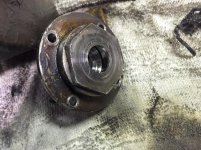Hi guys,
So I'm working on salvaging the overhead drive transmission from an old Ames instrument lathe. (details in different thread, just search "B.C. Ames".)
It turns out to have shaft seals made out of what looks like 3/16" jute twine. Some were just wrapped around the shaft of a control lever, fitted into a counterbore in the case casting. The rotating input and output shafts had stuffing boxes, stuffed with the same stuff. The only problem is that they were pretty clearly leaking before the unit was retired: the boxes are jammed down to maximum adjustment, and the shafts underneath have been scored. About .020" deep, by eye. (Pix attached.)
My questions are these:
(A) what modern material would you replace the twine with?
(B) what to do about the scored shafts? I could just knock everything off the current shafts, and replace them, but some of the transmission components are pinned in place, and I really don't want to measure out and re-drill all those holes if I can avoid it. They had a thing for tapered dowel pins, and I'm morbidly certain that these are 'reamed in place' tapered seats. Really don't want to fuss with those if I can avoid it.
Part of me thinks that the stuffing box might just adjust itself to deal with the scored shaft. The rest of me thinks the first half is way too optimistic.
Opinions? Experience? Wild Ass Guesses?
Don't know what the final output RPM is likely to be, but let's assume 1800 for now. Input probably 2K.
Regards,
Brian




So I'm working on salvaging the overhead drive transmission from an old Ames instrument lathe. (details in different thread, just search "B.C. Ames".)
It turns out to have shaft seals made out of what looks like 3/16" jute twine. Some were just wrapped around the shaft of a control lever, fitted into a counterbore in the case casting. The rotating input and output shafts had stuffing boxes, stuffed with the same stuff. The only problem is that they were pretty clearly leaking before the unit was retired: the boxes are jammed down to maximum adjustment, and the shafts underneath have been scored. About .020" deep, by eye. (Pix attached.)
My questions are these:
(A) what modern material would you replace the twine with?
(B) what to do about the scored shafts? I could just knock everything off the current shafts, and replace them, but some of the transmission components are pinned in place, and I really don't want to measure out and re-drill all those holes if I can avoid it. They had a thing for tapered dowel pins, and I'm morbidly certain that these are 'reamed in place' tapered seats. Really don't want to fuss with those if I can avoid it.
Part of me thinks that the stuffing box might just adjust itself to deal with the scored shaft. The rest of me thinks the first half is way too optimistic.
Opinions? Experience? Wild Ass Guesses?
Don't know what the final output RPM is likely to be, but let's assume 1800 for now. Input probably 2K.
Regards,
Brian





